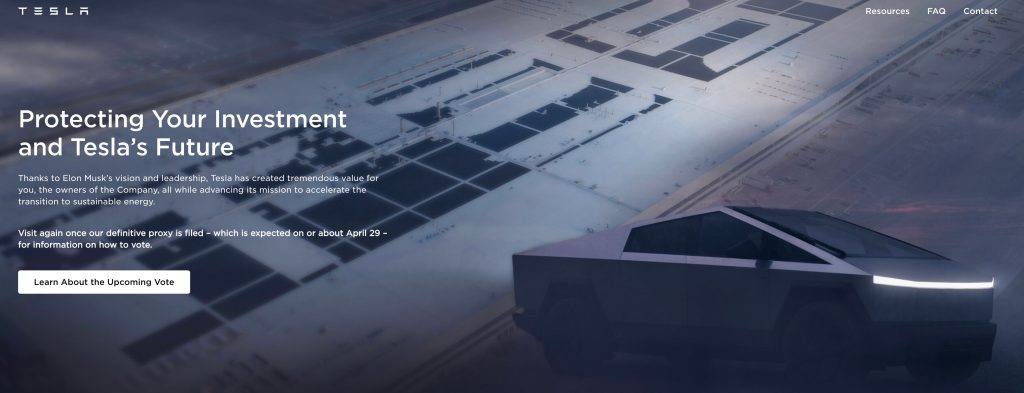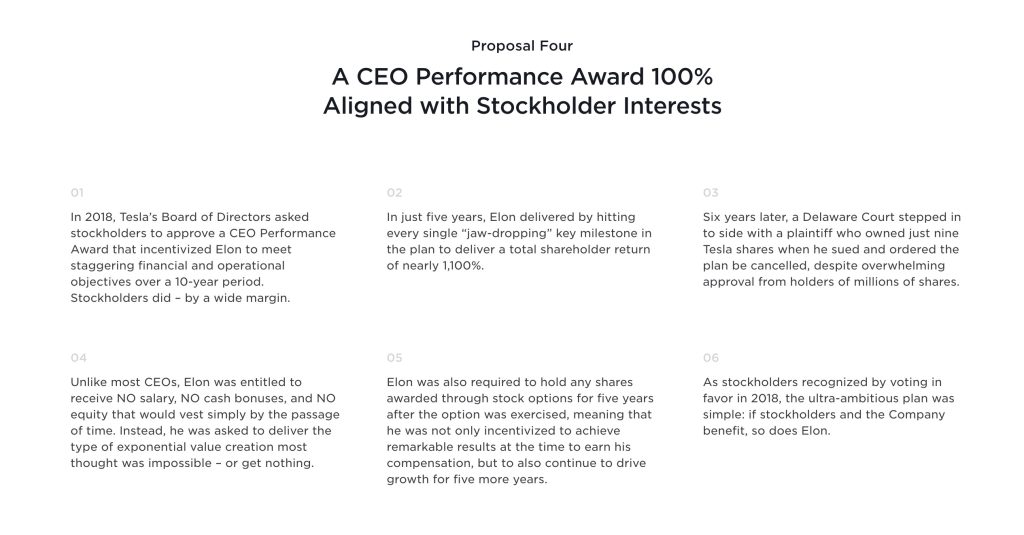
Tesla has launched a new website aimed at convincing shareholders to vote for reinstating Elon Musk’s $55 billion compensation plan.
Back in 2018, Tesla shareholders approved one of the biggest compensation plans of all-time: a $55 billion fully stock-based CEO compensation plan for Elon Musk.
In January, a judge sided with lawyers representing a Tesla shareholder alleging that Tesla’s board misrepresented the compensation package when presenting it to shareholders.
It’s a complicated issue, but in short, the judge found that Tesla’s board and Musk didn’t play by the rules of a public company when it presented the plan to shareholders.
The judge found that Tesla had governance issues when coming up with the compensation plan and those issues were not communicated to shareholders before voting on the plan.
Instead, Tesla claimed that the plan was negotiated by “independent board members” when it was found that some board directors had personal financial dealings with Musk outside of Tesla, amongst other things.
The Delaware court found that this invalidated the vote, and therefore, Tesla had to rescind the compensation plan.
Yesterday, Tesla told shareholders that it will ask them to vote on moving Tesla’s state of incorporation to Texas and then revote for Musk’s compensation plan without changing anything.
Now, Tesla has launched a new website called ‘SupportTeslaValue.com‘ to convince shareholders to vote for the package again.
The website opens up by claiming that giving the shares to Musk will “protect your investment and Tesla’s future”:

Most of the website is dedicated to the fact that the compensation plan was aligned with shareholders’ interests, super ambitious, and actually achieved the goals in the plan despite being super ambitious.
Virtually everyone can agree with all of that, but it’s not really what led the package to be rescinded.

The interests were aligned, but the judge did question the need for such a high compensation when Musk already owned more than 20% of Tesla at the time.
From the judge’s decision:
At a high level, the “6% for $600 billion” argument has a lot of appeal. But that appeal quickly fades when one remembers that Musk owned 21.9% of Tesla when the board approved his compensation plan. This ownership stake gave him every incentive to push Tesla to levels of transformative growth—Musk stood to gain over $10 billion for every $50 billion in market capitalization increase. Musk had no intention of leaving Tesla, and he made that clear at the outset of the process and throughout this litigation. Moreover, the compensation plan was not conditioned on Musk devoting any set amount of time to Tesla because the board never proposed such a term. Swept up by the rhetoric of “all upside,” or perhaps starry eyed by Musk’s superstar appeal, the board never asked the $55.8 billion question: Was the plan even necessary for Tesla to retain Musk and achieve its goals?
But the real issue is how the plan came about. The judge found that Musk was in control of Tesla and the board – leading to irregularities and how the plan was put together and negotiated.
That’s at the core of the judge decision and Tesla doesn’t really address it in its new SEC proxy statement and this new website.
This is the only section that sort of addresses it:

However, the testimonies from the Tesla board members, Musk, and everyone involved, led the judge to believe the work from the board wasn’t really “robust”.
For example, Todd Maron, a lawyer who represented Musk and formerly was his divorce lawyer, became Tesla’s general counsel when this plan was being negotiated:
The process leading to the approval of Musk’s compensation plan was deeply flawed. Musk had extensive ties with the persons tasked with negotiating on Tesla’s behalf. He had a 15-year relationship with the compensation committee chair, Ira Ehrenpreis. The other compensation committee member placed on the working group, Antonio Gracias, had business relationships with Musk dating back over 20 years, as well as the sort of personal relationship that had him vacationing with Musk’s family on a regular basis. The working group included management members who were beholden to Musk, such as General Counsel Todd Maron who was Musk’s former divorce attorney and whose admiration for Musk moved him to tears during his deposition. In fact, Maron was a primary gobetween Musk and the committee, and it is unclear on whose side Maron viewed himself. Yet many of the documents cited by the defendants as proof of a fair process were drafted by Maron.
That alone is a weird thing: having your divorce lawyer become your auto company’s general counsel.
The judge also argued that the board didn’t really negotiate the deal proposed by Musk. They made a few changes to align it with Tesla’s internal goals, but the judge believed the change couldn’t be described as “concessions” by Musk:
In this litigation, the defendants touted as concessions certain features of the compensation plan—a five-year holding period, an M&A adjustment, and a 12- tranche structure that required Tesla to increase market capitalization by $100 billion more than Musk had initially proposed to maximize compensation under the plan. But the holding period was adopted in part to increase the discount on the publicly disclosed grant price, the M&A adjustment was industry standard, and the 12-tranche structure was reached in an effort to translate Musk’s fully-diluted-share proposal to the board’s preferred total-outstanding-shares metric. It is not accurate to refer to these terms as concessions.
Tesla shareholders are going to vote on the plan again in June, along with the move to Texas and the re-election of two board members, including Musk’s brother, Kimbal Musk.
Electrek’s Take
Top comment by JPUX
I think the fact that they need a website now to convince shareholders says enough about how the relationship between the company's management and the shareholders has evolved.
Before voting, Tesla shareholders should look at more than the proxy and Tesla’s new website.
You should really read the judge’s decision, which includes excerpts from testimonies from basically everyone involved. It does undoubtedly paint the most accurate picture of how the plan came about – certainly more than the board saying they met 15 times to discuss this plan.
That’s all I’m asking. Read the judge’s decision.
Here’s the judge’s decision in full:
FTC: We use income earning auto affiliate links. More.






Comments